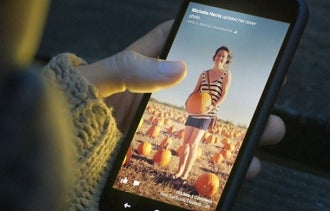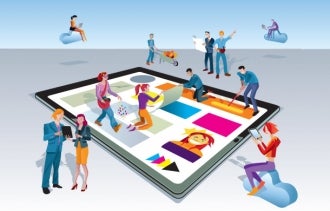
Samsung will announce its next flagship smartphone, the Galaxy S IV, next month on March 14. We know this because the company said so — an act simultaneously like and unlike the approach by its chief mobile rival, Apple.
Apply typically doesn't say anything about what it's going to unveil, preferring instead to shroud its events with false mystery — false because everyone always knows what Apple products are coming through rumors and leaks, even if they don't know the details. And Apple may tease (it did so with the iPhone 5, sending invites with a large "5" on them), but almost never pre-announces anything.
That's why Samsung giving the name of the product in advance isn't like Apple, but the fact that it's choosing to unveil a major product at its own marquee event is very Apple-like. Samsung is now the top smartphone maker worldwide, and its unveilings rightly command attention comparable to Apple's.
Even though Samsung's Galaxy phones lead all other Android models, the iPhone 5 is still the single most popular phone in the world. Samsung has come a long way since it was primarily known for appliances, but it's still in second place.
Nevertheless, there's no question it has the momentum. With the Galaxy S IV, it has an opportunity to do what seemed impossible less than a year ago: Overtake the iPhone as the No. 1 smartphone in the world (something it briefly did last year). Samsung can actually beat Apple at its own game.
However, Apple didn't rise to the top of the mobile world by accident. The iPhone still delivers one of the best experiences in smartphones, with a well-rounded ecosystem, and the hardware is beautiful. Samsung's Galaxy line doesn't have quite have all the pieces of the puzzle, but it could get there with the S IV. Here's how.
1. Bring on the Magic
Apple likes to toss around the word "magical" to describe its products, and although that's mostly Kool-Aid, there's some justification for it. Apple has done a good job of injecting the "wow" factor into its mobile products for the past six years, and although Android has caught up to a large extent in the last year with Jelly Bean, Apple was the one who pioneered many of the things that we take for granted in a mobile experience, such as fluid animation that responds instantly to touch.
Although it's harder to wow mobile users today, a few people are doing it. The screen of the new BlackBerry Z10, for example, uses sensors to detect finger swipes even in sleep mode, letting you wake it up without touching any physical buttons.
That's the kind of magical thing that Samsung is bordering on already with its Smart Stay feature, which uses the front-facing camera to detect if you're looking at the phone, keeping the screen from timing out. If the Galaxy S IV toook that to the next level by, say, letting you actually turn on the phone just by looking at it, or speaking to it, would be a good start to laying claim to some of that Apple "magic."
2. A Better Ecosystem
The fact that the iPhone is tied to iTunes — both the software and the store — has been a key part of its success. iCloud, along with its seamless backing up of photos and other content, has taken it a step further.
Samsung's ecosystem is comparatively weak. The company has a jumble of multiple digital storefronts (called "hubs"), its horribly named "AllShare" cloud-storage system, plus some partnerships with third parties including Dropbox and SugarSync. Compared to Apple's single-storefront, set-up-once system, Samsung's is a mess.
Samsung would do itself a world a good if, with the Galaxy S IV, it would finally offer a clear ecosystem. It should either cut away the partnerships and go all-in on its own system, or just use Google's, which isn't perfect either but at least Google Play is relatively consistent.
3. Fewer Tricks, More Features
Samsung's approach to the feature set on its smartphones — particularly the Galaxy S III — has been the shotgun approach: Blast a bunch of features at consumers with questionable usefulness, and something will hit. Smart Stay was a good idea; Share Shot (which lets a group of people share pictures at an event), not so much.

In addition, some of these functions aren't very well thought out. Having the GSIII's camera automatically suggest tags based on people's faces is good, but since those tags don't work with Facebook, it's not as useful as it could be.
While any feature will find its share of fans, giving users a grab bag of trinkets isn't nearly as good as giving a big gift they didn't even know they wanted. Apple's done this a few times with the iPhone, introducing major features features such as the Retina display, FaceTime, iCloud and Siri
Think about the Galaxy S III: What's it's standout feature, other than just being a Samsung Galaxy? With its successor, Samsung would benefit from focusing on one or two big features instead of inundating users with stupid gadget tricks. Quality over quantity.
4. Improved Durability
One of the sad truths about Samsung's phones is that they just kind of feel cheap. Recently, Samsung went with plastic backs for most of its mobile devices to cut down on weight (and probably production costs), but they've also had the effect of making the device appear low-end when you put it next to, say, the aluminium-unibody HTC One.
On top of that, the Galaxy S III has failed its share of drop tests that have left the iPhone 5 still ticking. It's not the world's most durable phone, partly because a its large (4.8-inch) screen is harder to protect than a smaller display.
At the same time, competitors such as Sony (whose new devices are waterproof) have found that durability is a differentiator that consumers care about. Phones get dropped, phones get dinged and phones get submerged — if it hasn't happened to you, it has to someone you know. If the Galaxy S IV actually ends up beating the iPhone 5 in stress tests, that's a headline that will be written over and over again.
5. Mobile Payments, for Real
Mobile payments on Samsung phones are already almost certainly in the works, and it represents a ball that Samsung has picked up because Apple left it lying on the ground. Mobile payments in many countries — especially the U.S. — is a big fat boondoggle because there are so many cooks in the kitchen, from wireless carriers to hardware manufacturers to merchants to ecosystem managers.
Getting all those stars to align is something only a multibillion-dollar company with a lot of market and mindshare could actually do. So far Apple has been reluctant to advance in mobile payments, leaving near-field communication (NFC) out of the iPhone 5 and instead offering its slow-to-catch-on Passbook app.
At Mobile World Congress, Samsung announced it was partnering with Visa to include NFC mobile payments on its phones. Since Visa works closely with merchants and is a partner in Isis (the carrier-blessed partnership for mobile payments in the U.S.), Samsung could finally be the company to take NFC payments mainstream in America.
All IV Nothing?
About a year ago, Samsung had just launched a marketing campaign specifically targeting Apple, painting its adherents as uncool and Samsung products as the "Next Big Thing." But when its commercial for the Galaxy Note (with a stylus!) debuted during Super Bowl 2012, many laughed Samsung off as the one that was out of touch.
No one's laughing anymore. Samsung's market share has skyrocketed, it's due to release it's second major smartphone since the iPhone 5 debuted, and Google is reportedly worried about how powerful it's getting. Some major developers are even building versions of their apps specifically for Samsung's products.
To keep the momentum going, however, Samsung needs to take the most important play from the Apple playbook: Deliver an outstanding product. With the Galaxy S IV, Samsung has a chance to steal Apple's mobile crown, but it needs to be a game-changer. All the marketing in the world can't make the next big thing out of an insignificant upgrade.
What would you like to see in the Samsung Galaxy S IV? Let us know in the comments.
Image via Josep Lago/AFP/Getty Images
Galaxy S III image courtesy of Samsung
View the
Original article





























































